The H2B visa is a nonimmigrant (temporary) visa for persons who are citizens from certain foreign countries to work temporary or seasonal (non-agricultural) skilled or unskilled jobs in the United States. H2B visa workers usually work full-time jobs in amusement parks, resorts, restaurants, hotels, housekeeping, and the landscaping industry.
Most H2B visas are cap-subject H2B visas where there is a total maximum limit (cap) of 66,000 H2B visas that can be given out each year. The cap-subject H2B visas are given out 2 times during USCIS’s fiscal year: (1) the first half (Oct. 1 – March 31) has 33,000 H2B visas and (2) the second half (April 1 – Sept. 30) has 33,000 H2B visas. When the H2B visa cap is reached (which is when the amount of H2B visa petitions received is more than the total amount of H2B visas that can be given out for that period), the H2B visa petition filed will enter the H2B visa lottery system for selection. If the H2B visa petition filed is selected, it will then go on to be reviewed and decided by the USCIS.
- 1.
- 2.
- 3.
- 4.
- 5.
- 6.
- 7.
- 8.
- 9.
- 10.
- 11.
- a.
- b.
- c.
Table of Contents
There are 2 types of H2B visas: the cap-subject H2B visas and the cap-exempt H2B visas.
Cap-Subject H2B Visas
A cap-subject H2B visa means that the H2B visa petition is affected by the total amount of H2B visas that can be given out that period (which usually means that the H2B visa petition may have to enter the H2B visa lottery system for selection if the amount of H2B visa petitions filed is more than the H2B visas that can be given out that year).
A total of 66,000 cap-subject H2B visas can be granted each fiscal year and it is consisted of 2 periods: (1) 33,000 visas for the first half (Oct. 1 – March 31) and (2) 33,000 for the second half (April 1 – Sept. 30).
H2B Visa Lottery System
When the amount of cap-subject H2B visa petitions received is more than quota of the H2B visas (i.e., 33,000 H2B visas) that can be given out for the time period, the H2B visa petitions will have to enter a lottery system that randomly selects which H2B visa petitions can continue to be reviewed for the given time period.
Winter Period H2B Visa Petitions
For cap-subject H2B visa petitions with employment start dates that fall within the winter period (October 1 to March 31), the Temporary Employment Certification (Form ETA-9142B) for the H2B visa petition must be filed with the U.S. Department of Labor (DOL) during the 3-day filing window in July (e.g., July 3 to July 5 of that same year) to go through the lottery system. In other words, the Temporary Employment Certification for H2B visa work in the winter period (i.e., work that starts on October 1) must be filed during the filing window in July to go through the H2B visa lottery.
Summer Period H2B Visa Petitions
For cap-subject H2B visa petitions with employment start dates that fall within the summer period (April 1 to September 30), the Temporary Employment Certification (Form ETA-9142B) for the H2B visa petition must be filed with the U.S. Department of Labor (DOL) during the 3-day filing window in January (e.g., January 1 to January 3 of that same year) to go through the lottery system. In other words, the Temporary Employment Certification for H2B visa work in the summer period (i.e., work that starts on April 1) must be filed during the filing window in January to go through the H2B visa lottery.
Cap-Exempt H2B Visas
A cap-exempt H2B visa means that the H2B visa petition is not affected by any limitation on the number of visas that can granted each year (i.e., there is no set limitation on the total amount of cap-exempt H2B visas that can be given out) and it can be filed anytime throughout the year unlike cap-subject H2B visas. There are 2 main types of workers under the cap-exempt H2B visa: (1) fish roe processors, fish roe technicians, or supervisors of fish roe processing, and (2) H2B visa workers in Guam and the Commonwealth of the Northern Mariana Islands (CNMI).

Under the H2B visa, the H2B visa worker must be from a national or citizen of certain countries that are participating in the H2B visa program and the H2B visa job must be only a “temporary need” for the U.S. employer.
The original statutory wording for qualified persons for H2B visas can be found in 8 CFR 214.2(h)(1)(ii)(D).
Qualified H2B Visa Worker
A qualified person under the H2B visa must (1) have the nationality or citizenship of an H2B visa participating country and (2) have the required qualifications for the H2B visa job position.
*Medical doctors are not included under H2B visas.
Athletes
Professional athletes who do not qualify for an O1A visa status (i.e., athletes with extraordinary ability) or P1A visa (i.e., internationally recognized athletes) status can seek an H2B visa status.
Entertainers
Entertainers who do not qualify for the O1B visa status (i.e., artists with extraordinary ability), P1B visa, (i.e., member of an internationally recognized entertainment group), or P3 visa (i.e., artists working under a culturally unique program) status can seek H2B visa status. Entertainers under the H2B visa include performers, technical staff, and support staff involved with the performance including carnival workers.
Canadian musicians who will be performing within a 50-mile area from the U.S.-Canadian border for 30 days or less are pre-certified and can file the H2B visa petition directly with the USCIS without the temporary labor certification and recruitment process with the DOL. The H2B visa petition can include the support staff of the Canadian musicians, such as drivers, stagehands, equipment handlers if they are connected to the H2B visa musician who will be working in the United States.
Qualified H2B Visa Job Position
A qualified job position under the H2B visa must be a temporary full-time job position that satisfies 1 of the 4 scenarios: the job has a (1) seasonal need, (2) peak load need, (3) intermittent need, and (4) a one-time occurrence need.
Typically, H2B visa job positions that are for a one-time need are given in 1-year increments (up to 3 years in total) and H2B visa job positions that have a seasonal need, peak load need, intermittent need are only granted up to 9 months due to the Temporary Employment Certification issued by the U.S. Department of Labor (DOL).
Mixed Job Positions
Under the H2B visa, job positions that are a mixed combination of occupations can be allowed if (1) the mixed job duties are usually required by the U.S. employer, (2) the U.S. employer usually hires employees for this type of job position, and (3) the workers in that geographical area usually perform those mixed job duties or it is a business necessity for workers to perform those mixed job duties. The offered wage to the H2B visa worker under a mixed job position must be the higher prevailing wage of the two occupations.
Foreign Language Skills
If the job position requires the H2B visa worker to have foreign language skills, it will most likely to be seen as restrictive unless it is inherently a part of the job such as translators or teachers in foreign languages.
Temporary Need
The focus of the job position under the H2B visa is whether the U.S. employer’s “need for temporary help” is temporary (i.e., the U.S. employer’s needs for the H2B visa worker is only for a limited period of time that will end in a near definable future). In most cases, H2B visas cannot be used for permanent positions such as professors, university chairs, lecturers.
Factors that will be used to evaluate whether the U.S. employer’s need for H2B visa workers are temporary include:
- (1)
- The H2B visa workers job duties
- (2)
- The nature of the U.S. employer’s business
- (3)
- Whether the U.S. employer needs that amount of temporary workers
- (4)
- Whether the U.S. employer needs those H2B visa workers throughout that period of time
- (5)
- Whether the U.S. employer has permanent employees in the same job duties
- (6)
- Whether the U.S. employer has filed for more than one H2B visa petition with the same job duties in one year
- (7)
- Whether other businesses related to the U.S. employer have also filed for H2B visa petitions
- (8)
- Whether the job position have periods of time that do not need H2B visa workers (especially if the H2B visa position requested is for a seasonal job position)
Nature of U.S. Employer's Business
Under the H2B visa, the nature of the U.S. employer’s business should not show a constant ongoing need for the type of temporary workers that it is sponsoring for an H2B visa because a continuous temporary need is equivalent to a permanent need. For example, a nightclub sponsoring singers and musicians is likely to be denied an H2B visa because the nature of the nightclub business usually requires singers and musicians to operate, or temporary staffing agencies that have a constant year-round need a pool of temporary workers to staff in other businesses. However, if the H2B visa worker is offered a job that requires skills that the business has an infrequent demand or non-recurring demand for, it is still possible for an H2B visa to be approved.
H2B Visa Job Staffing Agency
Job contracting agencies are only allowed to file for H2B visa job positions that are needed seasonally or for one-time only (which means that H2B visa job positions that are under peakload needs or intermittent needs cannot be filed for by job contracting agencies.) For example, a job staffing agency that regularly supplies workers for ski resorts during the months of October to March but does not supply any other similar workers to the ski resort for any other months will be qualified to file H2B visa positions for the job position under seasonal needs.
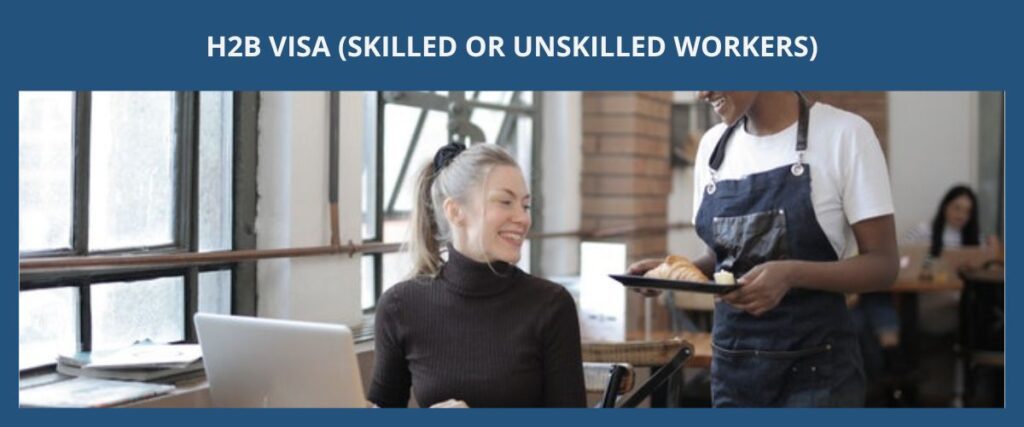
One-Time Occurrence
The H2B visa job position can be used for a job that is needed for a single project (or event) if the U.S. employer either (1) has not in the past and will not in the future have employees in the job position, or (2) have permanent employees in the job position but has a need for a temporary worker in the job position because of a brief temporary event. For example, an artisan installing religious artifacts in a temple for a U.S. employer or a production manager setting up and training new staff to use a new technological product in the business’s U.S. operations.
H2B visas under the one-time occurrence subcategory may be able to have a validity period of up to 3 years, however, a new Temporary Employment Certification must be filed every year (i.e., 1 year) because a Temporary Employment Certification issued by the U.S. Department of Labor can only be approved with a validity period of 1 year.
Seasonal Need
The H2B visa job position can be used for a job that is needed for a season which can include scenarios where (1) the seasonal need has a recurring nature and it is traditionally tied to a season of the year because of an event or pattern, (2) the business completely shuts down for a season, (3) when there is a predictable cyclical budget constraint, or (4) it is holiday season. The unemployment during the off-seasons cannot be unpredictable, subject to change, or just be vacation periods for the permanent employees of the U.S. employer.
Most H2B visa cases that are for seasonal needs are tied to the physical seasons. For example, musicians providing certain unique cultural experiences during the summer and fall, dining staff at resorts for the summer, or lifeguards in coastal regions for the summer.
Peakload Need
The H2B visa job position can be used for a peakload need where the U.S. employer has the need to add temporary workers to their existing regular permanent employees who work in that job position because of a seasonal or short-term demand. The H2B visa worker under the peakload need cannot eventually become a part of the U.S. employer’s regular business operations. For example, a toy manufacture has a product that was suddenly a big hit and resulted in a peakload need for their assembly-line due to the unexpected production demands for that year’s Christmas season.
Intermittent Need
The H2B visa job position can be used for an intermittent need where the U.S. employer (1) does not have permanent or full-time employees in that job position and (2) only has an occasional or intermittent need for temporary workers in that job position for a short period of time. For example, a sports manufacture that needs apparel workers when there are increased productions around major sporting events (e.g., super bowl), or an actress reshooting a movie scene.
H2B Visa Full-Time Job
The H2B visa job position must also be (1) a full-time job position which is at least 35 hours per week and (2) the total work hours offered to the H2B visa worker must be at least three-fourths (i.e., 75%) of the workdays (i.e., number of hours each day on the job order) in each 12-week periods (or 6-week periods if the H2B visa employment period is less than 120 days). If the H2B visa worker was not offered and thus did not work at least the guaranteed number of days, they must still be paid that amount by the U.S. employer under the three-fourths guarantee.
H2B Visa Wage Offered
The offered wage for the H2B visa worker must be the higher of either (1) the prevailing wage determined by the National Prevailing Wage Center (or the Federal, State, or local minimum wage whichever is higher) or (2) the actual wage that the U.S. employer pays to other similarly employed workers.
If the H2B visa job position is covered under a Collective Bargaining Agreement (CBA) with the union, then the offered wage for the H2B visa worker must be the wage set forth in the CBA agreement. The prevailing wage for professional athletes will be based on the wage set forth in the sport’s professional league’s rules and regulations.
The prevailing wage determination must be kept for 3 years from the date of issuance (or the date that the Temporary Employment Certification was approved whichever is later).
H2B Visa Salary Payment & Deductions
The offered wage under the H2B visa typically should not be based on commissions, bonuses, or other incentives including paying on a piece-rate basis unless the offered wage every workweek already satisfies what is required under the H2B visa.
In addition, the H2B visa worker should be paid at least every 2 weeks or according to the common practice where the H2B visa works (whichever is more frequent), and deductions must be authorized and any deductions not required by law must be disclosed in the job order. Authorized deductions from the H2B visa workers’ pay can include tax withholding and garnishments, union dues, and reasonable costs of room and board.
Cost of Transportation
The DOL requires the U.S. employer to cover the H2B visa worker’s cost to travel to their work location which includes meals and lodging during the traveling. This cost of traveling to the work location has to be paid to the H2B visa worker either (1) once they have completed 50% of the time covered by the job order, or (2) within the first week of work if the U.S. employer is covered by the Fair Labor Standards Act (FLSA).
A qualified H2B visa worker must have the nationality or citizenship of certain H2B visa participating countries (updated annually on the Federal Register) unless approving an H2B visa worker from a nonparticipating would be in the interest of the United States. The participating H2B visa countries are listed below:
Asia | North America |
|
|
South America | Central America |
|
|
Europe | |
|
|
Caribbean | Middle East |
|
|
Australia & Oceania | Africa |
|
|
Asia
|
Central America
|
North America
|
South America
|
Europe
|
Middle East
|
Caribbean
|
Africa
|
Australia & Oceania
|
The initial H2B visa can be granted a period of stay for up to 1 year (or to the validity period authorized by the Temporary Employment Certification which is typically no more than 10 months for most cases or 1 year for one-time occurrences) and renewals (extensions of stay) for one-time occurrences can be granted in 1-year increments until the maximum limit of 3 years is reached.
Time Recapturing
Unlike other H1 visas, the time H2B visa workers spend physically outside the United States cannot be recaptured for their H2B visa status unless the time spend physically outside the United States was (1) at least 45 days if the person stayed in an H2B visa status for 18 months or less, (2) between 2 months to 3 months if the person stayed in an H2B visa status for 18 months to 3 years, or (3) at least 3 months if the person stayed in an H2B visa status for 3 years.
3 Year Limitation
After the H2B visa worker spends 3 years in an H visa status or L visa status (does not include H4 visa status or L2 visa status), the person must be physically overseas (outside the United States) for the 3-month period immediately prior to filing for a new H2B visa petition.
H2B Visa Grace Period
The H2B visa worker is allowed to enter the United States 10 days before the start date and stay an additional 10 days after the end date. However, the H2B visa worker cannot work in those additional 20 days.
-eng-1024x427.jpg)
The H2B visa for the workers in (non-agricultural) skilled or unskilled labor job positions have five main requirements that need to be satisfied: evidence must be provided to the USCIS to show that (1) the H2B visa job position is a full-time job position, (2) the U.S. employer has a temporary need (i.e., seasonal, peakload, intermittent, one-time occurrence need) to fill the H2B visa job position, (3) the H2B visa worker has the nationality of an H2B visa participating country, (4) the H2B visa worker has the required qualifications to work in the job position, and (5) there are no U.S. workers who are qualified and available to take the job.
Documents Required for the H2B Visa (Skilled and Unskilled Workers)
The evidence provided to the USCIS for the H2B visa must show
- (A)
- The H2B visa job is temporary because it is a one time occurrence, seasonal need, peakload need, intermittent need
One Time Occurrence:
- The job is usually permanent but there is a temporary event (which lasts a short amount of time) creating the need for a temporary worker
- Have not employed workers to perform this service or labor in the past and will not do so in the future
OR
Seasonal Need:
- The work is traditionally tied to a season of the year by an event or pattern
- It is recurring
** Does not include time periods when unemployment during off-seasons is (a) unpredictable, (b) subject to change, or (c) considered a vacation period for permanent employees.
OR
Peakload Need:
- Regularly employs permanent workers for the work at the place of employment
- A need of temporary support to permanent staff at the place of employment because of a seasonal or short-term demand
- The temporary staff will not be part of the regular operation
OR
Intermittent Need:
- Have not employed permanent or full-time workers for the job position
- An occasional or intermittent need for short-term temporary workers for the job position
Evidence that shows the need for the H2B visa workers is only a temporary need for the U.S. employer can include but is not limited to:
- Documents that the U.S. employer’s need for H2B visa workers is a seasonal need, peakload need, intermittent need, or a one-time occurrence need (e.g., weather records, payroll records, sale records, contracts, tax records, letters of intent, organizational charts, media reports, trade publications, etc.)

- (B)
- There are no qualified and available U.S. workers for these jobs and hiring H2B visa workers will not negatively affect the wages and working conditions of similarly employed U.S. workers
Evidence that shows U.S. workers are not negatively affected by the H2B visa petition filing can include but is not limited to:
- Approved Temporary Labor Certification (Form ETA-9142B)
- Documents that show efforts to recruit U.S. workers (e.g., email of interviewing U.S. applicants, mail notifying former employees of the job position, phone logs, SWA job order)
- (C)
- The H2B visa worker has the nationality of a participating H2B visa country
Evidence that shows the H2B visa worker is a citizen or national of a participating H2B visa country can include but is not limited to:
- Passport (it should include biographical pages, related visa pages and stamps that show U.S. admission)
- Arrival-Departure Record (Form I-94)
- (D)
- The H2B visa worker has the required qualifications for the job position
Evidence that shows the H2B visa worker has the required qualifications for the job position can include but is not limited to:
- Diplomas, degrees, certificates, licenses, professional organizational memberships
- Foreign academic evaluation (if academic records are not from U.S., Canada or Mexico educational institutions)
- Letters from former employers to verify past work experience
- Business records (e.g., contracts, invoices, proof of payment, letters from current or former clients) to show past work experience if self-employed
The original statutory wording for the evidentiary requirements of the H2B visas can be found in 8 CFR 214.2(h)(6).
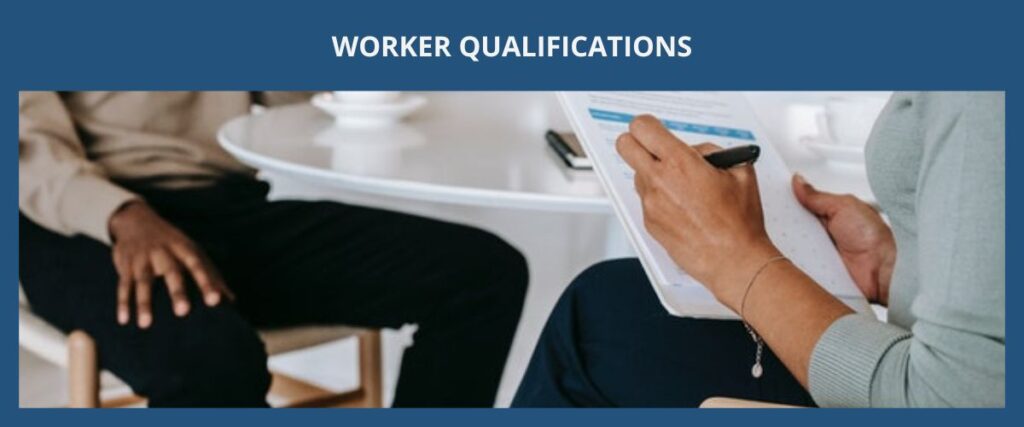
There are 5 main steps in the general process of obtaining an H2B visa:
Step 1: Job Offer for a Qualified H2B Visa Job Position from U.S. Sponsoring Employer
The H2B visa worker must have a job offer for a qualified H2B visa job position from a U.S. employer. The U.S. employer must be willing to sponsor (pay for and initiate) the H2B visa petition for the person which means that the H2B visa worker cannot self-sponsor themselves for an H2B visa. Job contracting agencies are joint employers with their U.S. employer clients.
Step 2: Filing for a Prevailing Wage Determination (Form ETA-9141) with the National Prevailing Wage Center (NPWC), a Job Order with the State Workforce Agency, and a Temporary Employment Certification (Form ETA-9142B) with the Chicago National Processing Center
Prevailing Wage Determination
The U.S. employer must first obtain a determination on the amount of wage that should be offered to an H2B visa worker under the specific job position and geographical location by filing a prevailing wage determination (Form ETA-9141) with the National Prevailing Wage Center (NPWC). The prevailing wage determination should be filed at least 60 days to 365 days before the H2B visa start date and the wage determined can be preserved for a validity of 90 days to 1 year starting from the date of approval. It is ideal to obtain the prevailing wage determination around the end of June for H2B visa petitions that will be filed next year.
State Workforce Agency Job Order
After obtaining the prevailing wage determination for the H2B visa, the U.S. employer typically files a job order (i.e., job advertisement) with the State Workforce Agency (SWA) within the 75-to-90-day period immediately before the H2B visa start date which results in the job advertisement being posted for at least 54 days due to the SWA job order being required to be posted up till 21 days before the H2B visa start date.
Temporary Employment Certification
When the U.S. employer files for the SWA job order, a Temporary Employment Certification is typically concurrently filed (i.e., filed at the same time) to the Chicago National Processing Center. The Temporary Employment Certification for the H2B visa should be filed 75 to 90 days before the H2B visa start date and must include (1) the Form ETA-9142B and Appendix B, (2) the prevailing wage determination (Form ETA-9141), (3) the SWA job order, and (4) any other supporting documents needed (e.g., contracts with recruiters or agents).
Canadian Musician Exception
Canadian musicians (include staff related to performance in the United States) who will be working within a 50-mile area from the U.S.-Canadian border for 30 days or less are pre-certified and do not need an approved temporary employment certification from the DOL (i.e., can skip the temporary employment certification application and recruitment process).
Step 3: U.S. Employer Recruitment Efforts and Obtaining an approved Temporary Employment Certification (Form ETA-9142B) from the Chicago National Processing Center
After filing the Temporary Employment Certification (Form ETA-9142B) and receiving a notice of acceptance (NOA) from the Chicago National Processing Center, the U.S. employer must then start to make an effort in recruiting U.S. workers for the H2B visa job position within 14 days which includes placing job advertisements of the H2B visa job position in local areas of the worksite or contacting former U.S. workers. If the U.S. employer receives a notice of deficiency (NOD) from the Chicago National Processing Center instead, then it must within 10 business days correct the errors listed to continue onto the recruitment process.
After the U.S. employer finishes the recruitment process for U.S. workers and does not find any U.S. workers to fill the H2B visa job position, the U.S. employer can then file their initial recruitment report to the Chicago National Processing Center to obtain a final certification of the Temporary Employment Certification. The initial recruitment report (i.e., the recruitment process) should continue to be updated until 21 days before the H2B visa start date because the U.S. employer is required to accept job applicant referrals until that day.
H2B Visa Job Advertisements
The H2B visa job advertisements must be placed on 2 separate days with one on Sunday in a newspaper that has a general circulation in the area of the worksite, or more typically the U.S. Department of Labor will post the H2B visa job advertisement electronically on its seasonal jobs website and the job applicants will be instructed to apply to the State Workforce Agency which may refer the job applicant to the U.S. employer for employment if the person is qualified and available to work in the H2B visa job position. In some cases, the U.S. employer may be required to do additional positive recruitment.
Recruiting Former Employees
Under the H2B visa, former employees who were (1) laid off within 120 days before the H2B visa start date (does not include employees who abandoned work or were dismissed for cause) or (2) employed in the H2B visa job position at the work location in the prior year should be notified of the job opportunity (i.e., the terms in the SWA job order) by mail or other effective means.
Notification of H2B Visa Job Position
The U.S. employer is required to place the H2B visa job posting in at least 2 conspicuous locations at the work location (or through electronic posting on intranet/electronic bulletin boards or a direct one-time email to affected employees) for at least 15 consecutive business days, or provide the relevant documents to the union representative if applicable.

Step 4: U.S. Employer Filing an H2B Visa Petition (Form I-129) with USCIS (And Go Through The H2B Visa Lottery System If Required)
After going through recruitment and obtaining an approved Temporary Employment Certification with the Chicago National Processing Center, the U.S. employer must then proceed to file an H2B visa petition (Form I-129) with the USCIS which includes (1) the certified ETA-9142B and Appendix B, (2) the prevailing wage determination (Form ETA-9141), and (3) all supporting documents required.
H2B Visa Lottery
If the H2B visa cap is reached for the given period (i.e., the number of cap-subject H2B visa petitions is higher than the number of H2B visas that can be given out during the given period), the U.S. Department of Labor will conduct a randomized selection (i.e., the H2B visa lottery system) of the Temporary Employment Certification applications filed for the cap-subject H2B visas.
To enter the randomized selection (i.e., the H2B visa lottery system), the Temporary Employment Certification (Form ETA-9142B) for cap-subject H2B visa petitions with an April 1 state date must be filed during the January filing window (Jan 1 – Jan 3) in the same year, and the Temporary Employment Certification (Form ETA-9142B) for cap-subject H2B visa petitions with an October 1 state date must be filed during the July filing window (July 3 – July 5) in the same year.
eng-1-1024x427.jpg)
Step 5: Consular Processing or Change of Status
After the H2B visa petition is approved by the USCIS, the person would need to change into their H2B visa status by consular processing at the U.S. consulate or embassy overseas (typically done for H2B visas), applying at the border (at the port of entry), or a change of status in the United States.
Change of status is usually for a person who is already in the United States with another valid nonimmigrant visa status and has maintained a lawful visa status throughout their time in the United States. On the other hand, consular processing is for a person who lives outside the United States or for a person who is ineligible to change their status in the United States due to noncompliance of U.S. immigration law (e.g., overstayed on their previous visa status, worked when they did not have valid U.S. work authorization, the visa status they used to enter the United States does not allow them to change into another type of visa status, etc.)
Person Outside U.S. (or Person Ineligible for Change of Status)
For a person who is residing overseas (outside the United States) or a person who is ineligible for change of status with the H2B visa petition (Form I-129), consular processing must be done to obtain the H2B visa status. Consular processing involves the person attending an in-person interview at the U.S. consulate or embassy usually in the person’s home country. In certain circumstances, a person can do consular processing in another country as a “Third Country National.”
After the interview approval at the U.S. consulate or embassy, the person would have to be admitted entry into the United States by the CBP officer at the border (usually at the airport) which means that the person would have to physically enter the United States as the final step for the H2B visa status to be activated.
Person Residing in the U.S. (Maintained Lawful Visa Status)
For a person who is already in the United States with another valid nonimmigrant visa, there are usually two options available to obtain the H2B visa status:
(1) Change of Status: this is the more commonly chosen option where the person states that they would like to change their status without leaving the United States in their H2B visa petition (Form I-129). If the person is eligible (no violations of U.S. immigration laws), then their nonimmigrant visa status will be changed upon the approved employment start date listed in the H2B visa petition. In cases where the person’s change of status request is denied or the person needs to change it into consular processing, an application for action on an approved application or petition (Form I-824) may be required.
(2) Consular Processing: this must be chosen if a person cannot show that they have maintained lawful visa status in the United States or for any other reasons such as the person needs to travel internationally before the H2B visa petition is approved.
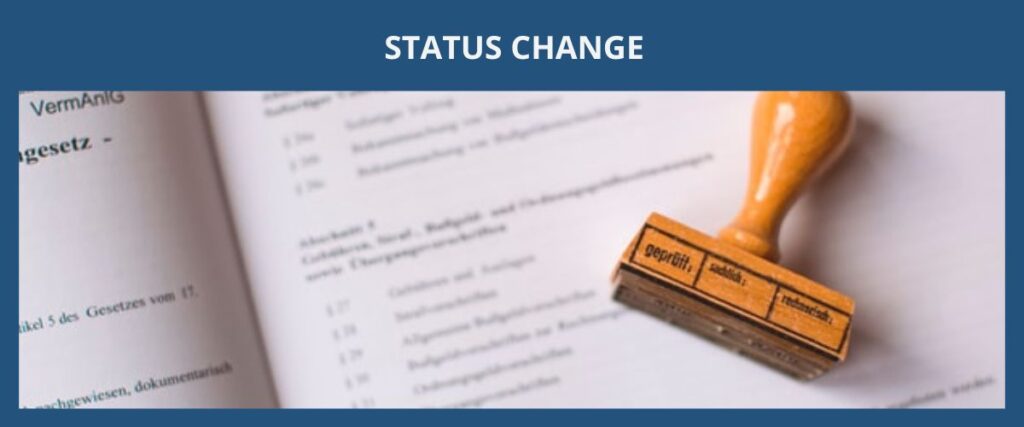
The total time a H2B visa takes is consisted of the processing time for the (1) Temporary Employment Certification (Form ETA-9142B) with the DOL (including the prevailing wage determination, SWA job order and the recruitment process for U.S. workers), (2) the H2B visa petition (Form I-129) with the USCIS and the (3) visa application (DS-160) at a U.S. consulate or embassy overseas if the person is not already in the United States or is ineligible to do a change of status within the United States.
Factors that influence the processing time usually include but are not limited to if there was any Request for Evidence (“RFE”), Request for Information (“RFI”), or Notice of Deficiency (“NOD”) issued, and the caseload of the USCIS service center and the U.S. consulate or embassy.
Premium Processing for Form I-129 (Expedited Service)
A rough estimate for the Form I-129 petition for the H2B visa is around 2 to 4 months. However, a 15-day premium processing (Form I-907) is available for the Form I-129 part of an H2B visa petition. Premium processing is an optional expedited service where the USCIS guarantees that the case will be processed within 15 calendar days (not business days). When a notice of intent to deny (NOID) or a request for evidence (RFE) is issued, a new 15 calendar days will start when the USCIS receives a response from the applicant. If the USCIS fails to process within the time frame, a refund of the service fee will be given and the case will continue to be expedited. Please note that USCIS’s guaranteed response may be an approval notice, denial notice, notice of intent to deny (NOID), request for evidence (RFE), or open an investigation for fraud or misrepresentation.
The current premium processing fee for the H2B visa is $2500 USD and it can be requested when the original petition is submitted to the USCIS or an upgrade to premium processing can be done when the case is pending.
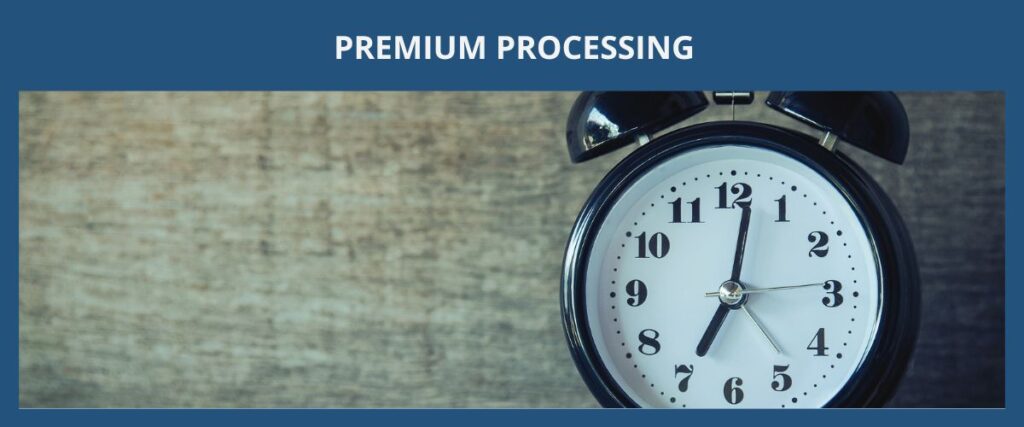
A change in employment for the H2B visa worker usually means that (1) there is a substitution for the H2B visa worker or a change in H2B visa employment dates, (2) the person will be working for another employer, (3) the person’s employment was terminated earlier than expected, or (4) there was a material change in the person’s employment or H2B visa eligibility.
Replacing H2B Visa Workers (Substituting H2B Visa Workers)
H2B visa workers overseas do not need to be named (but nationalities must be provided) in the H2B visa petition whereas H2B visa workers (does not include those who are already in an H2B visa status) who are already in the United States must be named if they are in the United States at the time of filing the H2B visa petition.
The number of workers requested in the H2B visa petition does not need to be the same as the approved number of workers listed in the Temporary Employment Certification, which means that the H2B visa petitions for the unnamed H2B visa workers in the Temporary Employment Certification can be filed at different times instead of having to be filed once in one H2B visa petition.
H2B visa workers (who were named or unnamed in the Temporary Employment Certification) approved for consular processing but has not been admitted to (physically entered) the United States yet can be substituted by notifying the U.S. consulate or embassy (or port of entry) of the H2B visa worker’s replacement with a written letter. Named H2B visa workers who are already in the United States cannot be replaced by a new H2B visa worker unless an amended H2B visa petition is filed with the USCIS.
Change in Employment Dates in Temporary Labor Certification
The H2B visa employment dates on the temporary labor certification can be changed by the DOL if (1) it is a change of the H2B visa start date and it is a change of 14 days or fewer (but cannot exceed the total amount of time allowed under the H2B visa), or (2) it is an extension request because there was weather conditions or other factors that are beyond the U.S. employer’s control (such as unexpected changes in market conditions), or (3) it is an extension request beyond the 9 month or 3 year limit due to extraordinary circumstances.
Change in Employer
If the H2B visa worker changes to a new employer, a new H2B visa petition must be filed by the new employer and the H2B visa worker cannot start working for the new U.S. sponsoring employer until the change of employer H2B visa petition is approved.
Amended Petition
An amended H2B visa petition would be required if there is a material change in the terms and conditions of the H2B visa worker’s employment or in the H2B visa worker’s visa eligibility. For example, the H2B visa worker’s work location changed to another location that is outside the geographical area listed in the Temporary Employment Certification with the DOL.
Early Termination
If the H2B visa worker’s employment was terminated involuntary (e.g., the H2B visa worker did not voluntarily resign) before their visa status expiration date, the sponsoring employer or agent would have an obligation to pay a reasonable transportation cost to the H2B visa worker to return to their last place of residence before coming to the United States.
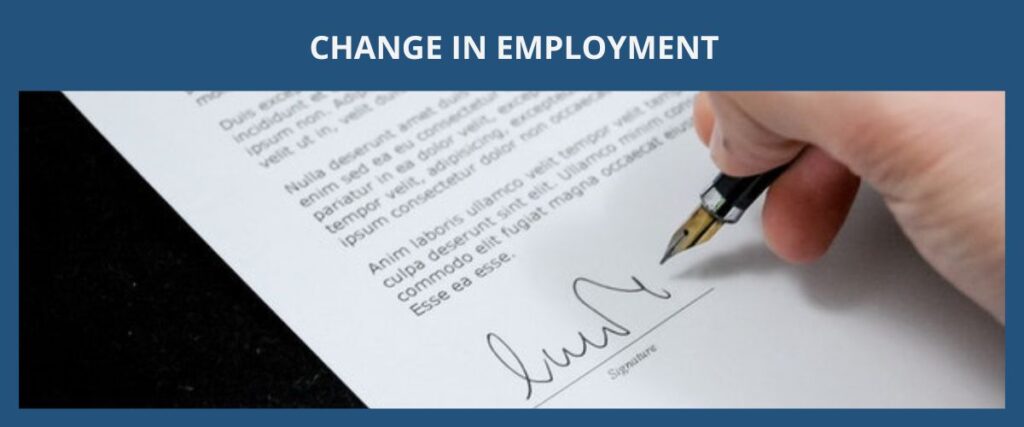
Dependent family members (spouse and unmarried children under 21 years old) of H2B visa workers are allowed to stay in the United States under the H4 visa status, however, H4 visa family members are not allowed to legally work in the United States.
Dual intent visas allow the foreign person to have both an intent to temporarily stay in the United States and an intent to permanently stay in the United States. The intention to permanently stay in the United States can be shown when the foreign person has a pending green card petition with the USCIS or an approved PERM labor certification from the U.S. Department of Labor.
The H2B visas are not dual intent visas which means that the timing of any green card application or petition must be carefully strategized because having dual intention (which is possessing an immigrant intent and a nonimmigrant intent at the same time) is not allowed for H2B visa workers. The H2B visa workers are only allowed to have nonimmigrant intent and are required to maintain a foreign residence (i.e. home address overseas) that they do not intend on abandoning.
Immigrant Intent Shown Under H2B Visa
Under the H2B visa workers, immigrant intent is not allowed and it is typically considered to be shown when a person has an approved PERM labor certificate or a pending green card application or petition (such as having an approved Form I-140). When the PERM labor certificate or pending green card petition is filed by the same U.S. entity as the H2B visa petition, immigrant intent is determined as shown even if the job positions are different and the H2B visa petition will be denied. However, if the PERM labor certificate or pending green card petition is filed by a different U.S. entity than the H2B visa petition, it is still possible to obtain an H2B visa but would most likely not be approved.
Troubles With Showing Dual Intent Under H2B Visa
Showing an immigrant intent can cause issues with the H2B visa worker’s eligibility to renew (extend) their visa or apply for other nonimmigrant (temporary) visas to travel to the United States. For example, an H2B visa renewal (extension) will be denied if the H2B visa worker has a green card petition filed for them.
Another issue that may arise when the H2B visa holder shows an immigrant intent is when they return to the United States after traveling internationally. For example, an H2B visa worker who has an approved PERM labor certification will likely be denied admission into the United States by the CBP officers at the border (e.g., airport) because the CBP officer will determine that the H2B visa worker is planning on staying in the United States permanently (as opposed to temporarily which is the only situation allowed for H2B visa workers). So, unlike people under visas (e.g., H1 visa, L1 visa) that allow dual intention, H2B visa workers cannot travel internationally after they have an approved PERM labor certification with the DOL or have filed for a green card petition with the USCIS.
The H2B visas are for U.S. employers to bring foreign workers from certain countries to work in (non-agricultural) skilled or unskilled job positions in the United States for a short period of time. The U.S. employer can file H2B visa petitions to fill job positions that have a seasonal need, intermittent need, peakload need, or a one-time need. Under most H2B visa cases, there is a mandatory recruitment process required by the U.S. Department of Labor (DOL) to show that the U.S. employer has made an effort to hire U.S. workers for the job position.

The alternatives to filing an H2B visa petition would usually require a higher standard for qualifications such as filing an H1b visa petition (Australians can file for E-3 visa petitions) for workers who have at least a bachelor’s degree and will be working in a professional job position that requires such as Bachelor’s degree, or a TN visa petition (only for Canadians or Mexicans) to work in a professional job position in the United States.
Another possible alternative to filing an H2B visa petition would be to file for a green card petition which is a permanent immigrant visa and not a temporary work visa like the H2B visa. Typically, a person who is qualifiable for an H2B visa would choose to file for an EB3 green card. For more on green cards gained through work, please read the overview for employment-based green cards.
The main difference between a green card and a temporary visa (such as an H2 visa, F1 visa, J1 visa, M1 visa, L1 visa, O1 visa, H1B visa, P1 visa, TN visa, E1 visa, E2 visa, E3 visa) is that a green card holder can legally work and freely change jobs among different employers without needing additional filings or approvals from the U.S. government. Also, unlike temporary visas, green cards are permanent so there is no set maximum time on how long a green card holder can stay in the United States.
When the H2B visa workers decide that they would like to live in the United States permanently and do not want to be subject to the time limitations or the constant filing requirements to extend (renew) their temporary work visa, the next step for them is to file a green card petition. The EB3 green card would typically be appropriate for the H2B visa workers, however, it must be cautioned for U.S. employers that are filing green card petitions for a worker who it has recently or is currently sponsoring an H2B visa status will face increased scrutiny due to requirements of the H2B visa (e.g., the H2B visa worker should only be coming to the United States to work temporarily). The job positions of the green card petition and the H2B visa should preferably be different when the U.S. employer is the same.
Furthermore, a person can qualify for an employment-based green card no matter where they are currently residing in the world. There is no pre-requisite as to the person being in some type of nonimmigrant visa status (such as an H2B visa) or having an educational degree from a U.S. school. In other words, a person who does not have a U.S. degree and has never been to the United States can still qualify for an employment-based green card. Thus, even if a person is not in an H2B visa status yet but does have the qualifications for an H2B visa, they can alternatively choose to file for an EB3 green card petition instead.
If you have an H2B visa (Temporary Skilled or Unskilled Worker) immigration question, please fill out our contact us form or send us an email with some basic information about your background and your immigration needs. We will do our best to respond within 48 hours.
How we can help?
Kylie Huang Law’s immigration attorney will help identify whether the H2B visa is the appropriate nonimmigrant visa category for the client’s (or the client’s beneficiary’s) professional background and if there are other visa options for the client (or the client’s beneficiary). We will work closely with our client to prepare a convincing case for their (or it’s) H2B visa petition and we will also strategize on how the H2B visa petition should be presented to achieve the best chances of approval. It is strongly advised and common practice to retain an immigration attorney for an H2B visa petition due to the complexities in the immigration process and visa requirements.
What does the typical process look like to retain (hire) us?
- Step 1:
- Step 2:
- Step 3:
- Step 4:
- Step 5:
- a.
- b.
- c.
- Step 6:
- Step 7:
- Step 8:
- Fill out the form (with some basic information on what your immigration needs are)
- Sign up and log into the client portal to schedule an appointment online
- Attend scheduled appointment (typically a phone call or zoom meeting)
- Retainment (signing a contract to hire us)
- Start processing case
- Gathering required documents
- Preparing paperwork
- Confirming contents of documents that will be submitted
- Filing the case
- Following up on the status of the case
- Close the case when a final determination is issued
- Step 1:
- Step 2:
- Step 3:
- Step 4:
- Step 5:
- a.
- b.
- c.
- Step 6:
- Step 7:
- Step 8:
- Fill out the form (on what your immigration needs are)
- Sign up and log into the client portal to schedule an appointment
- Attend scheduled appointment (typically a phone call or zoom)
- Retainment (signing a contract to hire us)
- Start processing case
- Gathering required documents
- Preparing paperwork
- Confirming contents of documents that will be submitted
- Filing the case
- Following up on the status of the case
- Close the case when a final determination is issued
- Step 1:
- Step 2:
- Step 3:
- Step 4:
- Step 5:
- a.
- b.
- c.
- Step 6:
- Step 7:
- Step 8:
- Fill out the form (on what your immigration needs are)
- Sign up and log into the client portal to schedule appointment
- Attend scheduled appointment (typically a phone call or zoom)
- Retainment (hire us)
- Start processing case
- Gathering required documents
- Preparing paperwork
- Confirming content of documents that will be submitted
- Filing the case
- Following up on the case status
- Close the case when a final determination is issued

